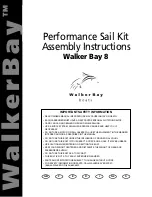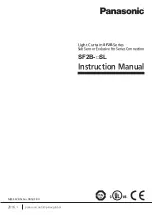
①
When mounting a spindle, refer to the Clamping Area etched on the spindle. (Fig. 9)
26
22
Clamping
Area
(
)
CLAMPING AREA
Fig. 9
②
When installing a spindle to the holder, recommended installation method is shown Fig 10. Refer to "
③
How to
fabricate the Split Type Holder ". If this is not possible, install as shown in Fig. 11.
Fastening Bolt
Split of Bushing
Split Bushing
ȭ
D
ȭ
D
ȭ
D
Slit
Split Type Holder
Fastening Bolt
Fastening Bolt
Spacer
Fig. 10
Fig. 11
Fig. 12
CAUTION
・
How to confirm the tightening standard of the holder by the clamp meter (In case of use a
brushless motor)
Measure the current value of the E3000 CONTROLLER / E2530 Control Unit's power cord by the
clamp meter.
Fasten the holder so that the increase in the no-load current value (during rotation at the
maximum rotation speed) with the spindle fastened is 20mA (for type 100V / 120V) / 10mA
(for type 200V / 230V) or less, compared to the no-load current value (during rotation at the
maximum rotation speed) without fastening the spindle. Do not over-tighten the Fastening Bolt.
It may damage spindle's precision and shorten the life of the bearings.
・
The final responsibility for ensuring holder's safety for use in a given application is left to the
designer of the equipment in which NAKANISHI's spindle is installed.
NAKANISHI offers spindles with a wide variety of capabilities and specifications.
Please carefully check the spindle's specifications against the requirements of your equipment
and verify suitability and safety of the Holder prior to initial use.
Fastening Bolt
Fastening Bolt
Spacer
Slit
Front View
Side View
Screw for Removal
Screw for Removal
Spacer
Fastening Bolt
Spacer
Fig. 14
③
How to fabricate the Split Type Holder
(
1
)
Roughly process (carve) the inside
diameter of the Split Type Holder.
(
2
)
Cut a slit. (Ex. Slit 2mm)
(
3
)
Twist the Screw for Removal and
Broaden the Slit Area.
(
4
)
Insert spacer (ex t = 2mm) into the Slit
Area.
(
5
)
Loosen the Screw for Removal, and
tighten the fastening bolt with the
specified torque.
(
6
)
Finish the Split Type Holder so that the
inside diameter of the Split Type Holder
is spindle's outside diameter (Refer to
Table 1). The correct tolerance range
for the holder is - 0.01mm to - 0.015mm
and a roundness and cylindricity of less
than 5μm.
(
7
)
When inserting the spindle loosen the
Fastening Bolt and twist the Screw for
Removal, and broaden the Slit Area.
Table 1.
Model
RAS - 101
RAS - 151E
ȭ
D
ȭ
22.8
ȭ
23
Steps
1
2
3
4
Air Pressure (MPa)
For Air Motor
0.1
0.2
0.3
0.4
Rotation Speed (min
-1
)
For brushless Motor
5,000
10,000
15,000
20,000
Rotation Time (min)
10
10
10
15
Items to Check
No Abnormal
Noises.
The spindle housing temperature during
the break-in process should not exceed
20 degrees C (36 degrees F) above
ambient temperature. Should the spindle
exceed this limit, rest the spindle for at
least 20 minutes and re-start the break
in procedure from the beginning. If the
housing temperature rises again and
exceeds 20 degrees C (36 degrees F)
above ambient temperature, check the
spindle and motor for proper installation.
The spindle
housing
temperature
during the
break-in process
should not
exceed 20
degrees C (36
degrees F)
above ambient
temperature.
Table 2.
7
. INSTALLATION OF THE SPINDLE
WARNING
When installing a spindle to a fixed base, make sure the fixed base is grounded in order to avoid
the risk of an electric shock.
CAUTION
・
When installing a spindle, do not hit, drop or cause shock to the spindle. This may cause
damage to internal components and result in malfunctions.
・
When mounting the spindle, be sure to mounting within clamping area etched on the spindle. If
the spindle is installed incorrectly, this will cause and damage to the spindle.
・
Cautions when tightening the securing bolt of the Split Type Holder
Do not over-tighten the bolt. This may cause damage to spindle's precision.
Tighten the bolt until the spindle body can not be turned by hand within the fixture.
Extreme tightening is not necessary or recommended.
Apply working force and check that the spindle is tight before using.
CAUTION
Do not allow set screws to come directly in contact with the spindle body as shown in Fig. 12, as
this will result in damage to the spindle housing and internal components.
When installing, never clamp directly over the bearings, as this will result in bearing damage.
(Refer to Fig. 13)
Bearing
Fastening Bolt
Fastening Bolt
Deformation
Damage of Internal
Components
Fig. 13
8
. BREAK-IN PROCEDURE
During transportation, storage or installation the grease inside the bearings will settle. If the spindle is suddenly run
at high-speed excessive heat will cause bearing damage. After installation, repair, initial operation, or long periods
of non operation please follow the break-in procedure detailed in Table 2.
Table
3. Overhang and Speed
Overhang (mm)
Max. Speed (min
-1
)
20
N x 0.5
25
N x 0.3
50
N x 0.1
※
N = Max. Operating Speed with
13mm overhang.
Fig.
15
3.14 x Diameter (mm) x rotation speed (min
-1
)
1,000 x 60
Surface Speed (m /s)
=
9. CAUTIONS WHEN USING GRINDSTONES AND TOOLS
①
The proper surface speed for general grindstones is 10 - 30m/s.
②
Do not exceed 13mm of overhang for mounted grindstones as shown in Fig. 15. If the overhang must exceed
13mm, reduce the motor speed in accordance with table 3.
③
Dress the grindstone prior to use.
④
Do not use cutting tools with bent or broken shanks, cracks or excessive run-out.
⑤
For grinding, the maximum depth of cut should not exceed 0.01mm radially or axially. Reciprocate the tool
several times after each pass to eliminate tool pressure.
⑥
Always operate cutting tools within the allowable recommended speed of the cutting tools. Use of a cutting
tool outside of the allowable speed of the cutting tools could cause damage to the spindle and injury to the
operator.
⑦
Keep the cutting tool shank and collet chuck clean. If contaminants are left in the collet chuck or chuck nut,
excessive run-out will cause damage to the cutting tool and or spindle.
⑧
Do not strike or disassemble the spindle.
⑨
Please set the cutting tools to minimize the overhang amount. 13mm is the maximum amount of overhang to
maintain high accuracy and safety.
13
CAUTION
The maximum surface speed or rpm is always specified for a grindstone. Do not exceed the
maximum speed with reference to the calculating chart below. Always follow the grindstone
manufacturer's recommendations.
Trouble
Cause
Inspection / Corrective Action
Spindle does not
rotate or rotate
smoothly.
The spindles bearings have been damaged.
Replace the ball bearings.
(Return to NAKANISHI dealer service.)
The motor has been damaged.
Replace the motor.
(Return to NAKANISHI dealer service.)
Overheating
during rotation.
Cutting debris has contaminated the ball
bearings, and the ball bearings are damaged.
Replace the ball bearings.
(Return to NAKANISHI dealer service.)
Abnormal
vibration or noise
during rotation.
The tool shank is bent.
Replace the tool.
Cutting debris has contaminated the ball
bearing.
Replace the ball bearings.
(Return to NAKANISHI dealer service.)
The spindles bearings have been damaged.
Tool slippage.
Collet chuck or chuck nut are not
correctly installed.
Check and clean the collet chuck and
chuck nut. Reinstall the collet chuck and
chuck nut.
The collet chuck and the chuck nut are worn.
Replace the collet chuck and chuck nut.
High run-out.
The tool is bent.
Change the tool.
Chuck nut is not correctly installed.
Secure the collet chuck and the chuck
nut correctly.
The collet chuck and the chuck nut are worn.
Replace the collet chuck and the chuck nut.
Inside of the spindle is worn.
Replace the spindle shaft.
(Return to NAKANISHI dealer service.)
Contaminants inside the collet chuck and
the chuck nut or the spindle.
Clean the collet chuck, chuck nut and
the inside of the taper and spindle.
The ball bearings are worn.
Replace the ball bearings.
(Return to NAKANISHI dealer service.)
10
. TROUBLESHOOTING
If a problem or concern occurs, please check the following prior to consulting your dealer.
2015.01.20 002




















